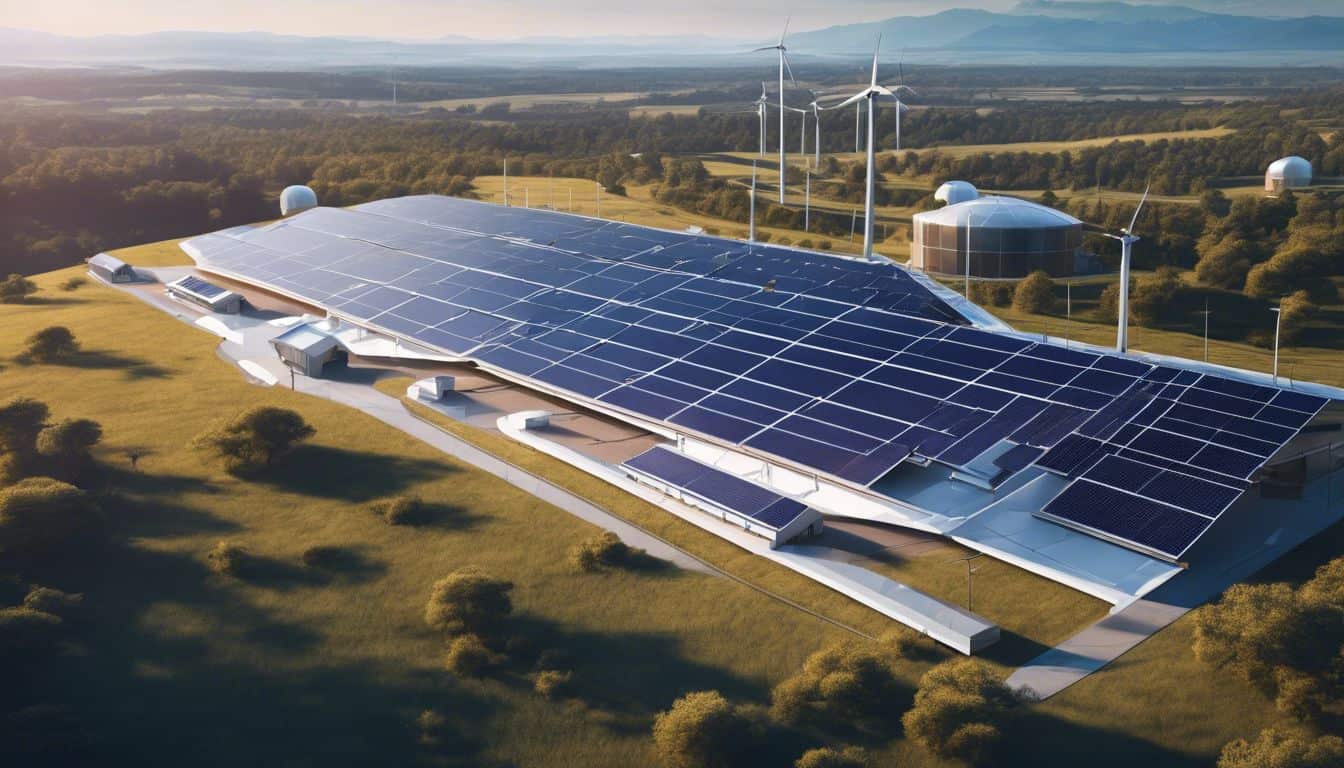Concentrated Solar Power (CSP) has emerged as a promising technology for clean electricity generation as the world shifts towards renewable energy sources. The evolution of concentrated solar power technologies has been remarkable, and now, artificial intelligence (AI) is set to revolutionize CSP operations, enhancing efficiency and reliability. This article explores how AI is transforming various aspects of CSP, from design and planning to real-time operations and maintenance.
AI Applications in CSP Design and Planning
Artificial intelligence is making significant contributions to CSP projects’ design and planning phases. One of the most impactful applications is in heliostat field layout optimization. AI algorithms can analyze complex factors such as land topography, solar angles, and shading effects to determine the most efficient arrangement of heliostats, maximizing energy capture while minimizing land use.
In solar receiver design, AI is used to optimize receivers’ shape and material properties, enhancing heat absorption and transfer efficiency. These AI-driven designs can lead to significant improvements in overall plant performance.
Predictive modeling powered by AI is also revolutionizing site selection for CSP plants. By analyzing vast datasets, including historical weather patterns, terrain characteristics, and infrastructure availability, AI can identify optimal locations for new CSP installations, potentially reducing project risks and costs.
AI-Driven Operational Improvements
Integrating AI into CSP operations yields substantial benefits in real-time plant management. Advanced AI systems can now continuously adjust heliostat alignment and tracking, ensuring optimal solar concentration throughout the day. This dynamic adjustment can significantly increase energy yield compared to traditional fixed-schedule tracking methods.
Predictive maintenance is another area where AI is making a big impact. By analyzing data from sensors throughout the plant, AI algorithms can detect potential equipment failures before they occur, allowing for proactive maintenance. This not only reduces downtime but also extends the lifespan of critical components.
AI has greatly enhanced weather forecasting, which is crucial for CSP operations. Machine learning models can now provide highly accurate short-term and long-term weather predictions, allowing plant operators to optimize production schedules and manage energy storage more effectively.
For a comprehensive look at the latest advancements in CSP technology, including AI applications, check out this guide to concentrated solar power innovations.
Enhancing CSP Efficiency through AI
AI is pivotal in optimizing thermal energy storage, a critical component of CSP systems. Advanced algorithms can predict energy demand patterns and optimize thermal storage systems’ charging and discharging cycles, ensuring maximum utilization of stored energy.
In grid integration, AI is helping CSP plants become more responsive to grid demands. AI systems can adjust plant output to maximize grid stability and economic returns by analyzing grid conditions and energy market data in real-time.
These AI-driven optimizations lead to overall system performance improvements, with some CSP plants reporting efficiency gains of up to 20% after implementing AI-based control systems.
AI in CSP Plant Monitoring and Control
Implementing AI in concentrated solar power maintenance and operation has transformed plant monitoring and control. Advanced control systems powered by AI can manage complex plant operations, making split-second decisions to optimize performance based on many factors.
Computer vision technologies are being deployed for equipment monitoring. Cameras and AI image recognition are used to detect issues such as mirror soiling or structural defects, allowing for more efficient and targeted maintenance activities.
Data analytics powered by AI is providing unprecedented insights into plant performance. By analyzing vast amounts of operational data, AI systems can identify subtle inefficiencies and suggest improvements that human operators might miss.
Challenges and Future Prospects
While the potential of AI in CSP is enormous, challenges remain. Data quality and availability can be issues, particularly for older plants that are not designed with AI integration in mind. There’s also the need to balance AI autonomy with human oversight, ensuring safe and responsible operation.
Looking to the future, we can expect to see even deeper integration of AI with Internet of Things (IoT) technologies in CSP plants. This could lead to fully autonomous CSP operations, where AI systems manage every aspect of plant operation, from solar tracking to grid integration.
The application of AI in CSP is not just transforming plant operations; it’s also creating new career opportunities in concentrated solar power. As technology advances, there’s a growing demand for professionals skilled in both renewable energy and AI technologies.

Conclusion
Artificial intelligence is undoubtedly reshaping the landscape of concentrated solar power. From optimizing plant design to enhancing real-time operations and maintenance, AI is driving significant improvements in the efficiency, reliability, and cost-effectiveness of CSP systems. As these technologies continue to evolve, we can expect CSP to play an increasingly important role in our renewable energy future, powered by AI’s intelligent capabilities.
FAQS
How does AI improve the efficiency of Concentrated Solar Power (CSP) systems?
AI boosts the efficiency of CSP systems in several key ways:
- Smart algorithms optimize solar tracking, ensuring mirrors and lenses are perfectly aligned with the sun’s path to maximize sunlight capture
- AI predicts the best times to store thermal energy and when to release it, ensuring energy is available during cloudy periods or high-demand times
- By analyzing data in real-time, AI helps CSP plants identify and address potential issues before they cause significant downtime or energy losses
- These AI-driven optimizations lead to increased energy production and a more stable, reliable power output from CSP plants
What role does predictive maintenance play in AI-optimized CSP operations?
Predictive maintenance is a crucial application of AI in CSP systems:
- AI algorithms continuously monitor data from sensors throughout the plant, looking for patterns that may indicate developing problems
- By identifying potential issues early, AI enables targeted maintenance before equipment fails, reducing downtime and repair costs
- Predictive maintenance helps extend the lifespan of CSP components, as proactive repairs prevent minor issues from escalating into major damage
- With AI-driven predictive maintenance, CSP plants can operate more reliably and cost-effectively, maximizing their contribution to the renewable energy mix
What real-world benefits have been demonstrated by AI in CSP plants?
Case studies highlight the tangible benefits of AI in optimizing CSP operations:
- In Spain, an AI-enhanced CSP plant increased its energy capture by 10% through improved solar tracking and storage optimization
- A Nevada CSP facility reduced its maintenance downtime by 25% after implementing AI-driven predictive maintenance
- These real-world examples demonstrate how AI can significantly boost the efficiency, reliability, and cost-effectiveness of CSP systems
- As more CSP plants adopt AI technologies, the cumulative benefits for the renewable energy sector will continue to grow
What challenges must be addressed for the successful implementation of AI in CSP?
While AI offers tremendous potential for optimizing CSP operations, there are some challenges to address:
- AI algorithms require large, high-quality data sets for training and operation, which can be difficult to obtain in the relatively young CSP industry
- Integrating AI systems with existing CSP infrastructure may require significant upgrades and investments in sensors, data storage, and processing power
- Ensuring the security and privacy of data collected by AI systems is crucial to maintaining trust and preventing unauthorized access or manipulation
- Addressing these challenges through collaboration, standardization, and ongoing research will be key to realizing the full benefits of AI in CSP
How can AI contribute to the growth and competitiveness of the CSP industry?
AI has the potential to drive the expansion and competitiveness of the CSP sector:
- By improving efficiency and reducing costs, AI makes CSP a more attractive option for utilities and investors looking to expand renewable energy capacity
- AI-optimized CSP plants can provide more reliable, dispatchable power, enhancing their value in the grid and their ability to complement intermittent renewables like wind and PV solar
- As AI helps CSP become more cost-effective and scalable, it can accelerate the transition to a clean energy future and contribute to global sustainability goals
- Continued research and development in AI for CSP will be crucial to maintain the industry’s growth and competitiveness in the rapidly evolving renewable energy landscape

Leave a Reply